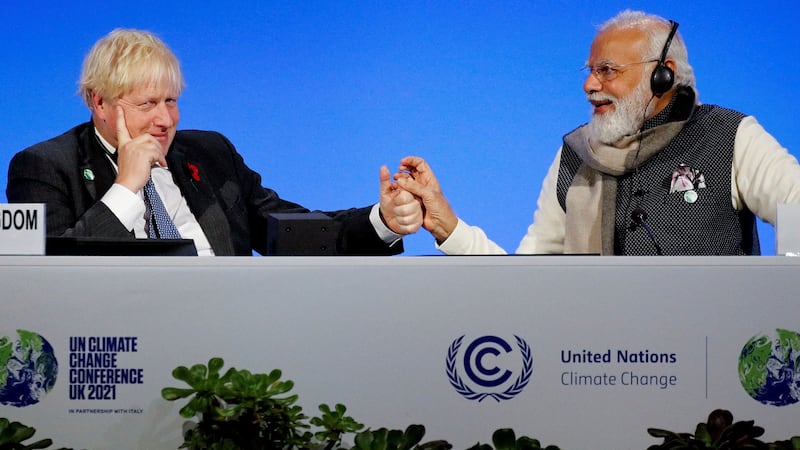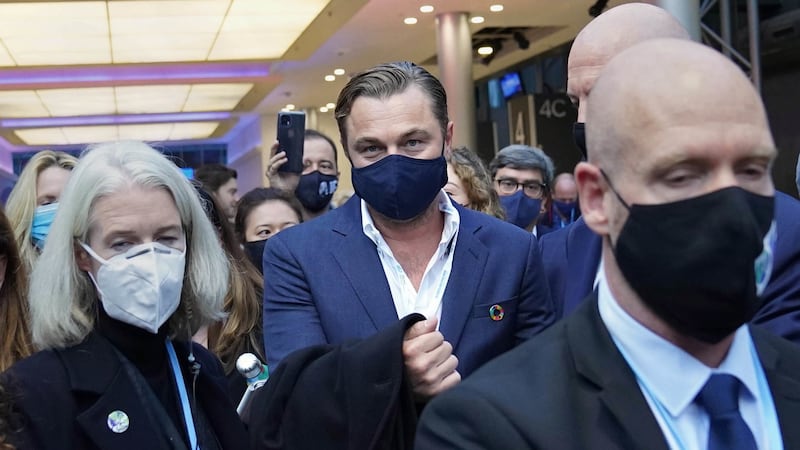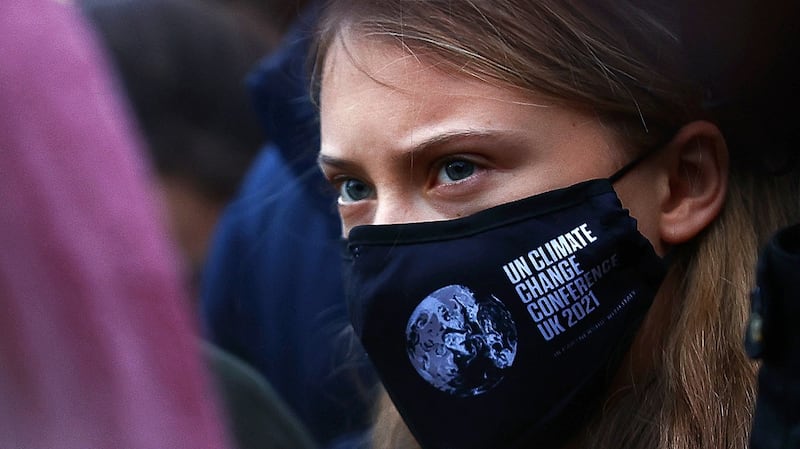On the surface the Cop26 Climate Summit and the protests outside of it look like two completely different worlds, but they're intrinsically connected. Unlike the man at the gates shouting into a loudhailer that "The global elite doesn't care about you, why are you going in?" few of the protesters think that what happens at Cop is a complete waste of time. Most people, inside and out, are headed in the same direction just with infuriatingly different senses of pace and urgency.
There are about 30,000 people in the Scottish Events Campus (SEC), and the place is vast and overwhelming. At one end of it, Zone F, where all the political negotiations happen, the clothes are more formal and the pace is brisker. This is where powerful people travel in huddles of functionaries, orbited by photographers.
Things have been achieved here already, though the details still need to be negotiated by hardworking civil servants and scientific advisers. The net zero pledges announced by world leaders in the first few days, coupled with the Global Methane Pledge, will keep temperature rises within 1.8 degrees (according to analysis from the International Energy Agency). That’s still short of the 1.5 degrees aspired to at Paris but it’s a big step.
They also worked to bridge the shortfall in the Green Climate Fund designed to help poorer countries adapt, so it should now reach the $100 billion a year promised in the Paris Agreement.
Yes, they’re just promises, but as UCC professor of energy engineering Brian Ó Gallachóir reminds me, change starts with promises. He’s cautiously optimistic.
I spend lots of time in the Delegate Pavilions where countries, agencies and NGOs compete for attention with talks, announcements and, sometimes, free food and coffee. It’s a lively place.

I encounter some scamps from Nuclear for Climate cadging coffee from the barista at the Global Wind Energy Council. “Obviously we welcome everyone,” says Rebecca Williams, director of this pavilion.
Nuclear for Climate’s David Watson turns around with expert timing to reveal the words “Together is better” on the back of his T-shirt.
Williams’s organisation has, when I arrive, just signed a “memorandum of understanding” with the Global Solar Council, and she introduces me to their chief executive Gianni Chianetta. Significant meetings are happening all over the place here – collaborative partnerships, announcements, rounds of applause.
Nuclear power is a harder sell due to the historical antipathy with which it is viewed by environmentalists. One of the Nuclear for Climate pitches is that a gummy bear-sized piece of plutonium creates the same amount of energy as a ton of coal, so they have a huge inflatable gummy bear at their stall.
They also have someone called Eric who sings opera arias with the lyrics changed to reflect benefits of nuclear power. “Nuclear Power is the key to universal prosperity, It is nuclear energy, we must embrace for the human raaaace.”
Yes, in some ways, Cop 26 can feel like a trade fair. But then you meet activists from all over the world who cared about the planet well before there was political capital in it, or representatives from poorer countries that are already suffering the sharper edges of ecological collapse.
The disconnect between the different versions of Cop26 can be jarring. There seems to be no natural overlap between Leonardo DiCaprio, who barrels through the Delegate Pavilions on Tuesday, and Vedant Kulkarni, an 18-year-old Indian activist, whose stay was made possible by a free room with a local family thanks to the Human Hotel’s Cop26 Homestay Network.
He’s an observer with the Youth Constituency of the UNFCCC and he sees the effects of climate change back home. “The crisis is changing our lives daily in terms of the water that we get access to, the heatwaves we face.”

There isn’t a clean line separating the delegates here and the protestors outside. One day as I’m leaving to join an Extinction Rebellion protest, I meet Emily Marsay and members of the UK Youth Climate Coalition inside the Blue Zone holding a hand printed banner that reads “$how us the Money”.
They’re protesting against Rishi Sunak’s plans to make Britain a “net zero finance centre”. “When they’re actually cutting their UK aid budget, they need to lead by example and give money not just relying on private finance to solve the climate crisis.”
Marsay feels that a lot of voices are missing from the summit, because of Covid and the price of travel and accommodation. Every day she and others liaise with the People’s Summit, held at various locations in the city, through which activists with accreditation feed information to and from those who couldn’t attend. “It’s the most exclusionary Cop yet… You’ve got a lot of people sleeping on sofas, sleeping in vans, camping.”
When I leave Marsay and exit the summit, there’s a small protest against carbon trading wrapping up outside the gates. “Carbon offsetting is a false climate solution that’s destroying indigenous communities,” says Eriel Deranger a delegate from the Athabasca Chipewyan First Nation and the executive director of Indigenous Climate Action.
“It gives polluters an excuse to keep polluting, and it needs to stop now. [They're] just creating forms of neo-colonialism [where] corporations and big polluting governments cook their books and allow heavy oil and gas projects to continue to proliferate, offset by purchasing conservation zones in other parts of the world.”
Like Marsay, she has her foot both inside and outside of the summit. “[Cop26] is necessary in the sense that we need climate action,” she says. “The problem is … the talks have become primarily [about] how to reconcile and stabilise the economy and then save the planet.”

Cop26 is undeniably hierarchical and exclusionary. This is why some protesters believe true climate justice requires an end to capitalism. But they also understand that climate change is an existential issue and that some version of Cop26 is a necessity. They don't want governments to stop engaging, they just want them to do more and do it more equitably. It's a huge disservice to the environmentalists whose activism has led the way, to conclude that it's all pointless just because Boris Johnson went home in a jet.
My favourite place at Cop26 is the Co-creative Reflection and Dialogue Space in a corner of the Delegates Pavilion. It’s run by the Institute for Advanced Sustainability Studies partly as an attempt to bridge all the conflicting energies I’ve described. “Because climate change is abstract and complex, it triggers the head and we lose the heart part,” says Carolin Fraude who helps facilitate the space with Malika Virah-Sawmy.
“In the protest movement they are expressing their frustration, their anger, their despair,” says Virah-Sawmy. She contrasts that with the atmosphere of optimistic busyness at Cop26. What goes unexpressed, she says, is everyone’s “feelings of frustration and fear and also a lot of shame and guilt... The culture doesn’t allow us to express feelings”.
So in this corner of the SEC they encourage people to talk about all that. They want to reconcile the head and the heart. They don’t get too many negotiators here, but people do stop out of curiosity, says Fraude.
“Because the moment people really engage in a meaningful or deep way you can see it has the quality of real conversation.”









